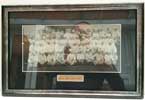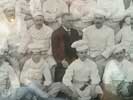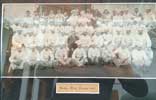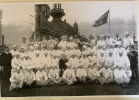An original b/w photograph of Auguste Escoffier.
SITTING WITH HIS FULL KITCHEN BRIGADE. 1905.
320 mm long x 153 mm high. Under the photograph is a small cut out of the original mount, stating; The Carlton Hotel. 1905. The photograph is mounted on a black cardboard border and covered by glass and bordered with a black and silver frame. One of his most famous pupils; Charles Scotto, sits in the photograph fourth from the left on the second row. Pasted on the back is the original photographer’s name in gilt, cut from the mount before it was framed. It was by Fradelle & Young, 283 Regents St. London W.1. They specialised in hotel and restaurant group photography of dinners, receptions & full kitchen brigades. ITEM 2. See image # 5. below. For reference; I requested a scan done by the framers of the original large photograph used. It shows in full a large ugly part of the Carlton Hotel roof, which was cut out before framing.
- This rare original photograph of Auguste Escoffier and his kitchen brigade, was taken on the roof of the Carlton Hotel 1905. A casual glance at this old image belies the contemporary history that Escoffier brought about by very hard work, his great extensive writings, his organisational skills, and a huge passion to improve the lot of his beloved chefs. It is one of the reasons why he is held in such high esteem, and a feeling of deep gratitude lies in the hearts of most well trained modern chefs, because his updated re-organisation of the large Kitchen brigade is still the way modern kitchens are organised. The following list is of the different members and departments of his large kitchen brigade system. Only the largest of hotels like the Carlton Hotel had this fully staffed brigade (54 people in this photograph) with all the following departments fully functioning. Escoffier devised this system, primarily during his time at the Savoy Hotel London, before going to the Carlton from 1899 to 1919. This very efficient organisation allowed sincere chefs to learn all the important skills of every department in the largest kitchen brigades. Staring at the top was the MAITRE-CHEF de CUISINE (literally translated; "Master Chef") Responsible for overall management of kitchen; supervises staff, creates menus and new recipes with the assistance of the restaurant manager, makes purchases of raw food items, trains apprentices, and maintains a sanitary and hygienic environment for the preparation of food. SOUS-CHEF de CUISINE (deputy head chef; literally "sub-chief") Receives orders directly from the chef de cuisine for the management of the kitchen, and often serves as the representative when the chef de cuisine is not present. Does not usually work on the stove anymore. In a big brigade there can be as many as 4-6 sous-chefs. CHEF de PARTIE (senior chef of a department) Responsible for managing a department in the kitchen, specializing in preparing particular dishes there. CHEF TOURNANT (Can be a Chef de partie in any department) The most experienced, having trained as a Chef de partie in every department. Will cover for any Chef de partie on their days off or holidays. Usually fills any vacancy for the Sous-chef’s position. CHEF SAUCIER (Chef de partie of the sauce dept.) Prepares all meat sauces and stocks and completes meat dishes. This is one of the most respected positions in the kitchen brigade. CHEF ROTTISEUR (Chef de partie of the roast department.) Manages a team of cooks that roasts, broils, and deep fries dishes. CHEF POISSONNIER (Chef de partie of the fish department.) Prepares all fish and seafood dishes and fish sauces and stocks. Usually has a fishmonger in the department. CHEF ENTREMETIER (Chef de partie of vegetable and farinaceous department.) Prepares all vegetables, soups and egg dishes. CHEF GARDE-MANAGER (Chef de partie of the cold larder.) Responsible for preparation of cold hors d'oeuvres, pâtés, terrines and aspics; prepares salads; organizes large buffet displays; and prepares charcuterie items. Usually the largest staffed department in the kitchen. CHEF PATTISIER (Chef de partie of pastry department.) Prepares desserts and other meal-end sweets, ices, cakes, petit-fours, pulled sugar works, also has a ‘boulanger’, preparing breads and other baked items; may also prepare pasta for the restaurant. BOUCHER (the butcher) Butchers meats, poultry, prepare meats for the Garde manger’s pates and terrines. Clean all game ready for roasting. May also be in charge of breading meats. CUISINIER (cook) May also be referred to as a cuisinier de partie. Also known as a ‘demi-chef de partie’ who takes over from the Chef de partie on his days off. COMMIS (junior cook) Works in a specific partie, but reports directly to the chef de partie. Can also be 2nd or 3rd commis depending on age and experience. The Chef de cuisine changes their departments annually to give them all round experience of all ‘parties’. APPRENTIE (apprentice.) Often students gaining theoretical and practical training, in school and work experience in the kitchen. They perform preparatory work under a Chef de Partie. PLONGEUR or MARMITON (dishwasher or kitchen porter.) cleans dishes and utensils, and may be entrusted with basic preparatory jobs. ABOYEUR (announcer/expediter) During the meal service times takes the orders from the dining room waiters and distributes them to the various departments; the role usually performed by the Sous-chef. CHEF COMMUNARD Prepares the meal served to the restaurant staff. GARCON de CUISINE (literally ‘kitchen boy’) In larger establishments, performs preparatory and auxiliary work for support. This photograph gives an insight into how many chefs are employed in the large well known luxury hotels. The range of skills that have to be mastered is huge. A commis chef's apprenticeship usually lasted up to 7 years. Even after that, a lot of chefs move to other well known establishments to gain more experience. Indeed a great chef's career path is always dictated by quality and reputation. Because the initial years as an apprentice is so tough and very focused on improving skills, they never lose the desire to learn. As a foot note and interestingly, in all photographs I have viewed of Escoffier sitting with his full kitchen brigades, (and they were done annually) He always sat sideways to the direct camera angle. Curious.!





click on image to enlarge

Ephemera category
ref number:
11230